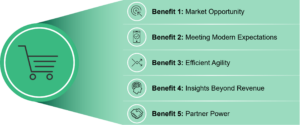Unleashing The B2B Revolution: The Bold Power Of E-Commerce
Drawing from my personal experience and passion for e-commerce, I am excited to share research on the compelling reasons and effective strategies for B2B organizations to harness this route to market that will propel their organizational growth. In parallel, this blog marks the commencement of a six-part series, set to be released over the next three months. The series delves into various perspectives and intriguing topics surrounding B2B e-commerce. Stay tuned for a deeper exploration of this dynamic landscape!
In the fast-paced world of B2B, where digital transformations are reshaping industries, there’s a powerhouse waiting to be unleashed: e-commerce. It’s time for chief marketing officers to grab the reins and lead their organizations into the future, tapping into the colossal potential of B2B e-commerce. Here’s why it’s not just a good idea but an imperative:
- Market opportunity: the billion-dollar goldmine. Picture this: the B2B e-commerce market in the US alone skyrocketing to a staggering $3.067 trillion by 2027, with an 11% compound annual growth rate. Yet shockingly, only 13% of B2B decision-makers see e-commerce as their primary revenue source. The numbers don’t lie — the market potential is colossal, and the time to claim your share is now. Don’t be part of the 87% playing catch-up; be the disruptor, not the disrupted.
- Meeting modern expectations: adapt or fade away. In an era where B2B buyers demand seamless online experiences, e-commerce is no longer a choice — it’s a necessity. Evolving buyer expectations require a more nuanced approach, and e-commerce delivers just that. With granular customer segmentation at scale, value creation through insights, and a tailored buyer approach, it’s the key to staying ahead. Embrace e-commerce, or risk being left in the digital dust.
- Efficient agility: turbocharge your growth. Efficiency is the name of the game, and e-commerce is the ace up your sleeve. Cut costs, scale with ease, and reach a broader buyer base efficiently. Say goodbye to chasing leads with lower potential, and empower your sales team to focus on high-impact accounts. Agility is the secret sauce — faster time-to-market and nimble responses to ever-changing business landscapes. Forrester’s 2022 data reveals that over a third of respondents value this agility; it’s time to join the club.
- Insights beyond revenue: know your buyers inside-out. It’s not just about the bottom line — e-commerce is a goldmine for capturing invaluable buyer insights. Understand search behavior, product preferences, and payment methods. Implement feedback loops to refine your strategy. Rapid A/B-testing for pricing, promotions, and marketing campaigns becomes a breeze. It’s not just e-commerce; it’s a treasure trove of actionable intelligence.
- Partner power: elevate together. Think beyond transactions; think partnerships. E-commerce isn’t just about what you sell; it’s about expanding value for complementary solution partners. Bundle offerings, recommend partner solutions, and create a symbiotic relationship. For 40% of forward-thinking organizations, it’s about elevating the success of their partners. E-commerce isn’t just a platform; it’s a gateway to collaborative success.
In the age of B2B e-commerce, standing still means falling behind. The revolution is here, and CMOs hold the key. It’s time to unlock the potential, disrupt the norm, and propel your organization into a future where e-commerce isn’t just an option — it’s the digital heartbeat of B2B success. CMOs hold a pivotal role in kick-starting and maximizing the potential of e-commerce within their organizations. To harness the advantages of e-commerce for organizational growth, CMOs need to unveil the needs and preferences of their target buyer segments. This entails delivering a compelling buyer and customer experience throughout the entire customer lifecycle. Integration of all pertinent internal and external stakeholders is essential, transcending the boundaries of the organization. Discover more in the new research, B2B CMOs Must Champion E-Commerce As A Growth Driver.

